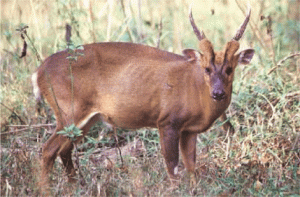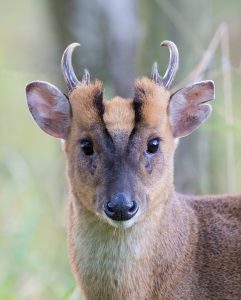Podcast: Play in new window | Download (Duration: 10:58 — 12.2MB)
Thanks to Chuck for suggesting this week’s topic, a weird little deer called the muntjac!
Further reading:
Dam Project Reveals Secret Sanctuary of Vanishing Deer
A giant muntjac [photo by Mark Kostich, taken from article linked above]:

A Reeve’s muntjac [photo by Don Southerland, taken from this site]:

Show transcript:
Welcome to Strange Animals Podcast. I’m your host, Kate Shaw.
This week we have a suggestion from Chuck, who wanted to learn about a small hoofed animal that I don’t think we’ve ever covered before, the muntjac. It’s a deer, but it’s a very weird deer.
In fact, it’s not just one deer, it’s at least 12 different species that are native to parts of south and southeast Asia, although it used to have a much broader range. Muntjac fossils have been found throughout Europe in particular. It prefers thick forests with lots of water around. Most species live in tropical or subtropical areas, although it can tolerate colder temperatures. It eats leaves, grass, fruit, seeds, and other plant parts, and it will also sometimes eat bird eggs and small animals when it finds them. It will even sometimes eat carrion.
The typical muntjac is small, barely larger than a fox. The largest species, the giant muntjac, stands a little over two and a half feet tall at the shoulder, or 80 cm, while there are several species of muntjac that don’t grow taller than 15 inches high, or 40 cm. It’s brown or reddish-brown, sometimes with darker or lighter markings depending on species. The muntjac appears hump-backed in shape like a rabbit, since instead of having a mostly level back, its back slopes upward from the shoulders to the rump. Its tail is very short and males grow short antlers that either have no branches or only one branch. Males also have a single pair of sharp, curved fangs that grow down from the upper jaw, more properly called tusks.
The muntjac is usually a solitary animal, with each individual defending a small territory. Both males and females have a large gland near the eye that secretes an oily substance with a strong smell. It also has another pair of scent glands on the forehead. The muntjac rubs its face on the ground to mark the edges of its territory with scent. It can even flare its scent glands open to communicate with other muntjacs by smell more effectively.
Unlike many deer species, the muntjac doesn’t have a particular mating season. Females, called does, can come into season any time of the year, so males are always ready to fight with other males for a doe’s attention. The male loses and regrows his antlers yearly, but mainly he only uses them to push an opponent over. He does the real fighting with his fangs.
There are other types of hoofed animals with fangs. We talked about the musk deer and the chevrotain in episode 116, but even though the chevrotain in particular looks a lot like the muntjac, it’s not closely related to it at all. Neither is the musk deer. In fact, neither the musk deer nor the chevrotain are actually deer, and they’re not even closely related to each other.
The southern red muntjac is one of the smallest species of muntjac known and is fairly common throughout much of southeast Asia, although we don’t know much about it. One thing we do know is that it has the smallest number of chromosomes of any mammal ever studied. Males have 7 diploid chromosomes and females only have 6. In comparison, the common Reeve’s muntjac has 46 diploid chromosomes. Scientists have no idea why there’s so much difference in chromosome count between species, but it works for the muntjac.
Many species of muntjac are common and are doing just fine, but others are endangered due to habitat loss, hunting, and the other usual factors we talk about a lot. But the muntjac is small, solitary, and very shy, so there are also species that are probably still waiting to be discovered.
The giant muntjac, also called the large-antlered muntjac, was only discovered in 1994 from a skull found in Vietnam. Scientists were eager to learn more about the animal, especially whether it was still alive or had gone extinct. They talked to hunters and other local people in Vietnam and Laos, and set up camera traps, and went on expeditions searching for it. The hunters said it was still around but the scientists just couldn’t find any. It wasn’t until 1997 that a camera trap took a few pictures of one near a newly constructed dam, which gave everyone hope that this animal could be saved from possible extinction.
Scientists had been searching for the giant muntjac for so long, and had only finally gotten a photograph after 13 years of trying, that they figured it would be an even longer time before they learned more about it. But then, suddenly, only four months after the first pictures of the giant muntjac were captured, a team of conservationists working to relocate animals from the flood area of the new dam ended up capturing 38 of the deer.
When a new dam is constructed across a river or other waterway, it doesn’t flood right away. It takes a long time for the water to back up behind the dam and turn into a lake or large pond, sometimes several years depending on the size of the dam and the waterway. There’s time to relocate animals to higher ground so they’ll be safe, and that’s exactly what Ulrike Streicher and her team were doing in 2007. Not only that, they made sure to transport the animals to a protected area where they’d be safer from hunters. Before they released the giant muntjacs, they had the opportunity to study them and fit some of them with radio collars so the scientists could track where they went. It turned out that the muntjacs settled into their new home just fine, so although the giant muntjac is still classified as critically endangered, at least we know that one small population is doing well.
Another muntjac search involves a camera trap in Vietnam and Laos too, but it’s still an ongoing mystery. The story actually starts back in 1929 when a dead muntjac was sent to the Field Museum in Chicago. The scientists at the museum couldn’t identify it as any known species of muntjac, so they described it in 1932 as Muntiacus rooseveltorum, also called Roosevelt’s muntjac. Modern genetic testing of the specimen determined that it’s a subspecies of Fea’s muntjac that lives in a small area of southern Myanmar and Thailand. Fea’s muntjac itself is so rare and so little known that we don’t even know if it’s extinct or not. As for Roosevelt’s muntjac, no one had seen it since the 1929 specimen was killed and it was presumed extinct.
Then, starting in 2014, a team of scientists conducted surveys in parts of the Annamites, a mountain range along the Vietnam/Laos border. Over the next five or six years, camera traps recorded every animal that passed by them in various remote locations. In addition to lots of animals the scientists expected to see, they found three animals that were either extremely rare or thought extinct. One of these was the Annamite striped rabbit we talked about in episode 254, but the other two were muntjacs.
One of the muntjacs captured on camera was identified as Roosevelt’s muntjac while the other was identified as the Annamite muntjac, a species that was only identified in 1997. The problem is that we only have pictures of the animals, and only a single specimen of Roosevelt’s muntjac to compare the pictures to. Scientists disagree as to whether Roosevelt’s muntjac is for sure still alive and well in the Annamite mountains, or whether the pictures are of a totally different species of muntjac. At least the pictures were taken in a nature reserve, so we know the muntjacs should be safe.
Muntjacs are such strange, attractive animals that rich people used to keep them as pets to show off. Sometimes they would escape into the wild, or were even released on purpose, and that’s why Japan, England, Wales, Belgium, the Netherlands, and Ireland all have invasive populations of Reeve’s muntjac. Reeve’s muntjac is common in southeastern China and Taiwan and only grows a little over a foot high at the shoulder, or maybe half a meter. The male has stubby little antlers and long tusks, so that his tusks are almost as long as his antlers. Cute as the animals are, they’re also bad for the local ecosystems, since they reproduce quickly and eat food that native animals need.
Rumors have circulated for a few decades now of another possible mystery muntjac, usually referred to as the quang khem. Supposedly it’s a large muntjac with unbranched antlers that lives in remote areas of Vietnam. So far it hasn’t been discovered, if it exists at all, but there’s definitely a chance that it’s yet another muntjac that’s just waiting to be spotted by scientists or their camera traps.
The muntjac is sometimes called the barking deer because of its alarm call. This is what a muntjac sounds like:
[muntjac barking sound]
You can find Strange Animals Podcast at strangeanimalspodcast.blubrry.net. That’s blueberry without any E’s. If you have questions, comments, or suggestions for future episodes, email us at strangeanimalspodcast@gmail.com. We also have a Patreon at patreon.com/strangeanimalspodcast if you’d like to support us for as little as one dollar a month and get monthly bonus episodes.
Thanks for listening!